Know your geography, know your wines
You straighten up your jacket,
and remembered what this article and perhaps other articles taught you on choosing
wines 101.
How does the climate affect wines?
Remembering what your geography and science teacher has taught you will be able to come in handy, in satisfying your palate.
In general the formula works like this:
In warm climate regions away from the equator, where days are long and photosynthesis ensures
that the vines get plenty of sugar.
The grapes will also ripen quicker than their cooler climate counterparts, resulting in lesser time absorbing minerals and other components from the vines.
As heat makes the plants sweat faster, the plant reacts by metabolizing malic acid for energy especially during the ‘veraison’ phase.
The grapes will also ripen quicker than their cooler climate counterparts, resulting in lesser time absorbing minerals and other components from the vines.
As heat makes the plants sweat faster, the plant reacts by metabolizing malic acid for energy especially during the ‘veraison’ phase.
The opposite is true for cooler climate regions.
The grapes having experience lesser sunlight, would spend more time on the vines and hence absorbing more minerals as well as spice components.
Having cooler climates, also mean that the plant doesn’t have to work as hard and hence more malic acids are conserve.
The grapes having experience lesser sunlight, would spend more time on the vines and hence absorbing more minerals as well as spice components.
Having cooler climates, also mean that the plant doesn’t have to work as hard and hence more malic acids are conserve.
Like a head chef, it is then the winemakers job to ensure the equation
is well balance by picking at the right moments, selecting the right grapes to
grow and of course the right blend.
In general, warm climates produce more fruit forward, fuller body but
less acidic wines.
Whereas cooler climates produce more mineral, acidic and aromatic wines but lacks the body.
Whereas cooler climates produce more mineral, acidic and aromatic wines but lacks the body.
[ Image credit: Wine Folly]
Notable warm climate regions would be Australia, South Africa, Argentina and Southern Italy/Spain
Notable cool climate regions would be Germany, Austria, New Zealand, Chile, France and Northen Italy/Spain
Putting it all together
Warm climate wines with a fuller body and alcohol levels tend to make big bold statements. It gives the wines a masculine taste profile which heightens one's sensors.
Cool climate wines have a more elegant and gentle touch and at the same time refreshing feel. If you prefer lightly seasoned food, you would probably appreciate cool climate wines better
Here are some suggestions:
1.) If you are someone who likes your wines to be of hard rock or heavy metal category.
South Australian (Coonawarra, Barossa or McLaren Vale) Cabernet Sauvignon, Shiraz
South Africa (Swartland Region), Rhone blends, Shiraz, Cabernet Sauvignon
Italian (Lombardy) Nebbiolo
2.) If you are someone who likes your wines to dance to the tune of ballet and classical music
French (Burgundy) Pinot Noir, Chardonnay
New Zealand Pinot Noir, Sauvignon Blanc
Chilean Red blends
Have fun choosing wines at the next wine fair or your next grocery shopping!
Gerard Zhang
CSW, WSET





Comments
Post a Comment